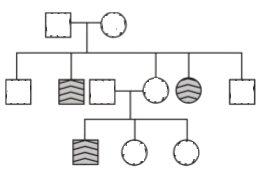In case of starch synthesis in pea seeds [controlled by B gene], BB homozygotes produce large and round starch grains; bb homozygotes produce smaller and wrinkled starch grains and Heterozygotes produce round seeds of intermediate size. What can be inferred from this observation?
(1) The gene B mutates at a faster rate.
(2) The gene B is easily influenced by the environment
(3) Dominance is not an autonomous feature of a gene or the product that it has information for
(4) Some genes do not follow the law of segregation.
"When two pairs of traits are combined in a hybrid, segregation of one pair of characters is independent of the other pair of characters". This is the statement of:
(1) Law of Dominance
(2) law of segregation
(3) Law of Independent Assortment
(4) Law of Linkage
A test cross is done to find out
(1) Fitness of an organism
(2) Genotype of a plant expressing dominant phenotype
(3) The suitable parents for a Mendelian Cross
(4) The hidden genotypic ratio of F2 phenotypes
In a monohybrid cross F1 progeny resemble neither of the parents. What would be true in this case?
1. The parental traits would not appear in any of the F2 -progenies
2. The F2 phenotypic ratio will be different from the F2 genotypic ratio
3. It could be a case of incomplete donminance
4. The F2 genotypic ratio will be similar to any Mendelian monohybrid cross
The two alleles of a gene pair are located on:
1. Homologous sites on homologous chromosomes
2. Heterologous sites on homologous chromosomes
3. Homologous sites on heterologous chromosomes
4. Heterologous sites on heretologous chromosomes
Male heterogamety is not seen in:
(1) Humans
(2) Melandrium album
(3) Birds
(4) Fruit fly
The trait shown in the given pedigree chart is most likely a/an:

1. Autosomal recessive trait
2. Autosomal dominant trait
3. Sex linked recessive trait
4. Sex linked dominant trait
Which of the following are correct regarding linked genes?
I. are locaed near each other on the same chromosome.
II. violate the law of independent assortment
III. segregate together during meiosis
(1) Only I and II
(2) Only I and III
(3) Only II and III
(4) I, II, III
Consider the cross AaBb x AaBb. If the alleles for both genes exhibit complete dominance, what genotypic ratio is expected in the resulting offspring?
1. 1:1:1:1
2. 9:3:3:1
3. 3:6:3:1:2:1
4. 1:2:1:2:4:2:1:2:1
Two phenotypically normal individuals have an affected child. What can we conclude about the parents?
1. they both carried the diesease allele
2. they are not the parents of the child
3. they are affected
4. no conclusions can be drawn






